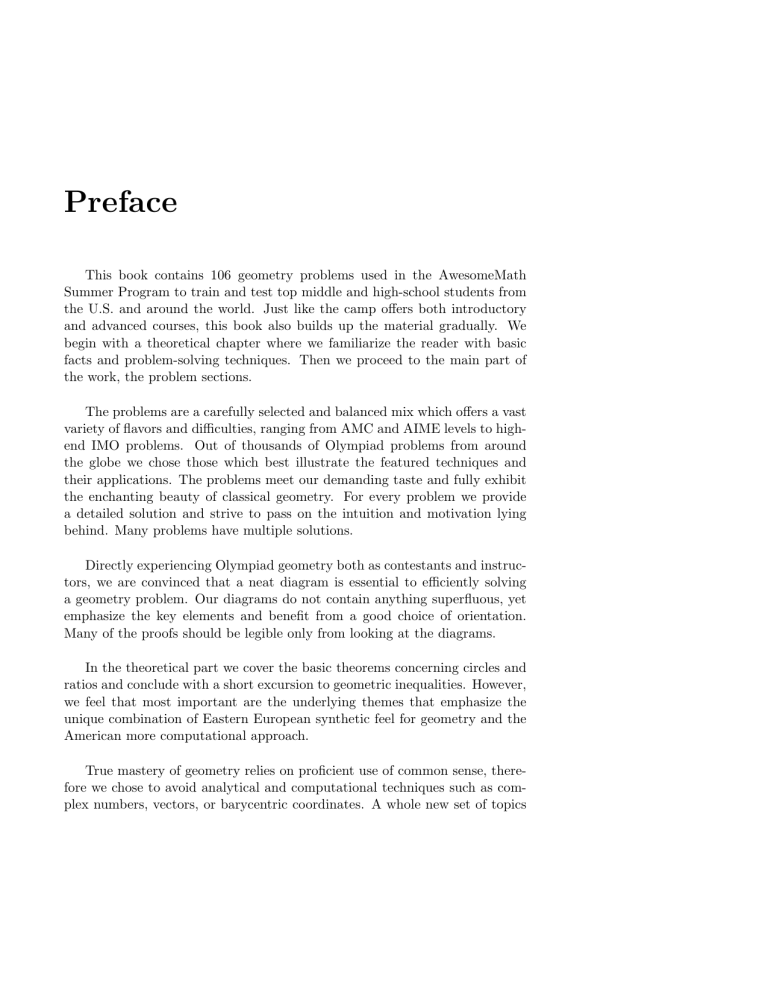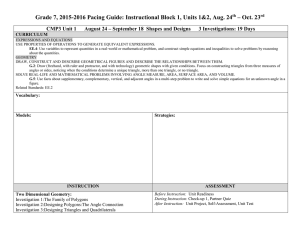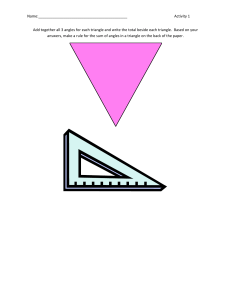
Preface This book contains 106 geometry problems used in the AwesomeMath Summer Program to train and test top middle and high-school students from the U.S. and around the world. Just like the camp offers both introductory and advanced courses, this book also builds up the material gradually. We begin with a theoretical chapter where we familiarize the reader with basic facts and problem-solving techniques. Then we proceed to the main part of the work, the problem sections. The problems are a carefully selected and balanced mix which offers a vast variety of flavors and difficulties, ranging from AMC and AIME levels to highend IMO problems. Out of thousands of Olympiad problems from around the globe we chose those which best illustrate the featured techniques and their applications. The problems meet our demanding taste and fully exhibit the enchanting beauty of classical geometry. For every problem we provide a detailed solution and strive to pass on the intuition and motivation lying behind. Many problems have multiple solutions. Directly experiencing Olympiad geometry both as contestants and instructors, we are convinced that a neat diagram is essential to efficiently solving a geometry problem. Our diagrams do not contain anything superfluous, yet emphasize the key elements and benefit from a good choice of orientation. Many of the proofs should be legible only from looking at the diagrams. In the theoretical part we cover the basic theorems concerning circles and ratios and conclude with a short excursion to geometric inequalities. However, we feel that most important are the underlying themes that emphasize the unique combination of Eastern European synthetic feel for geometry and the American more computational approach. True mastery of geometry relies on proficient use of common sense, therefore we chose to avoid analytical and computational techniques such as complex numbers, vectors, or barycentric coordinates. A whole new set of topics vi Preface will be presented in the sequel to this book: 107 Geometry Problems from the AwesomeMath Year-Round Program. Although the primary audience for this book consists of high-performing students and their teachers, anyone with an interest in Euclidean geometry or recreational mathematics is invited to join this geometric excursion. Finally, we would like to express our gratitude to Richard Stong and Cosmin Pohoaţă for critiquing the entire manuscript and providing fruitful comments. We wish you a pleasant reading. The Authors Abbreviations and Notation Notation of geometrical elements ∠BAC ∠(p, q) ∠BAC ≡ ∠B 0 AC 0 AB AB X ∈ AB X = AC ∩ BD 4ABC [ABC] [A1 . . . An ] AB k CD AB ⊥ CD p(X, ω) 4ABC ∼ = 4DEF 4ABC ∼ 4DEF convex angle by vertex A directed angle between lines p and q angles BAC and B 0 AC 0 coincide line through points A and B, distance between points A and B directed segment from point A to point B X lies on the line AB X is the intersection of the lines AC and BD triangle ABC area of 4ABC area of polygon A1 . . . An lines AB and CD are parallel lines AB and CD are perpendicular power of point X with respect to circle ω triangles ABC and DEF are congruent (in this order of vertices) triangles ABC and DEF are similar (in this order of vertices) viii Abbreviations and Notation Notation of triangle elements a, b, c ∠A, ∠B, ∠C s x, y, z r R K ha , hb , hc ma , mb , mc la , lb , lc ra , rb , rc sides or side lengths of 4ABC angles by vertices A, B, and C of 4ABC semiperimeter expressions 21 (b + c − a), 12 (c + a − b), 12 (a + b − c) inradius circumradius area altitudes in 4ABC medians in 4ABC angle bisectors (segments) in 4ABC exradii in 4ABC Abbreviations AMC10 AMC12 AIME USAJMO USAMO USA TST MEMO IMO American Mathematics Contest 10 American Mathematics Contest 12 American Invitational Mathematics Examination United States of America Junior Mathematical Olympiad United States of America Mathematical Olympiad United States of America IMO Team Selection Test Middle European Mathematical Olympiad International Mathematical Olympiad Contents Preface v Abbreviations and Notation 1 Foundations of Geometry Preliminaries . . . . . . Metric Relations . . . . Circles, Angles . . . . . Ratios . . . . . . . . . . Few Notes on Geometric vii . . . . . . . . . . . . . . . . . . . . . . . . . . . . Inequalities . . . . . . . . . . . . . . . . . . . . . . . . . . . . . . . . . . . . . . . . . . . . . . . . . . . . . . . . . . . . . . . . . . . . . . . . . . . . . . . . . . . . . . . . . . 1 1 10 26 42 58 2 Introductory Problems 63 3 Advanced Problems 69 4 Solutions to Introductory Problems 77 5 Solutions to Advanced Problems 117 Further Reading 165 Other Books from XYZ Press 171 Index 173 Chapter 1 Foundations of Geometry Preliminaries We begin our voyage to the fascinating world of classical geometry by reviewing some elementary facts. Basic Angles We state the following: • Vertical angles are equal. • A line subtends the same angle with any two parallel lines. In other words, alternate angles are equal. • In triangle ABC we have AB = AC if and only if ∠B = ∠C. The last two parts of the previous statement need to be taken seriously. The second one offers an efficient way to deal with parallel lines and the third one is one of the very few which translates angles into distances and vice versa. A B C We are ready to prove the universally known theorem on the sum of internal angles in a triangle. In addition, we prove a slight extension, which often offers tiny but pleasant shortcuts in angle calculations. 2 106 Geometry Problems Proposition 1.1. Let ABC be a triangle with angles ∠A, ∠B, ∠C. Then: (a) ∠A + ∠B + ∠C = 180◦ . (b) The external angle by vertex C equals ∠A + ∠B. Proof. For (a) draw a line through point A parallel with BC. Since the three angles by vertex A add up to 180◦ , we arrive at the result by using alternate angles. A A B C B C In order to prove (b) we just note that the external angle by vertex C is supplementary to ∠C as well as the sum ∠A + ∠B (by part (a)). Also, we know all it takes to prove the Inscribed Angle Theorem, which will later form our understanding of circles. Theorem 1.2 (Inscribed Angle Theorem). Let BC be a chord of a circle ω centered at O and let A ∈ ω, A 6= B, C. Then the inscribed angle BAC corresponding to arc BC equals one half of the central angle corresponding to the same arc. Proof. Assume first O lies inside triangle ABC. A ω O B C From isosceles triangles OAB and OAC (radii are equal!) we infer ∠OAB = ∠OBA and ∠OAC = ∠OCA. Then if we extend ray AO beyond O we can find ∠BOC as sum of two external angles. We see that ∠BOC = 2∠BAO + 2∠OAC = 2∠BAC 1. Foundations of Geometry 3 which is exactly what we wanted. The case when O lies outside or on the boundary of triangle ABC is treated in the same fashion with a few of the additions becoming subtractions. Triangle Congruence and Similarity Informally, we say that two triangles are congruent if they have the same shape and size. Of course, once two triangles are congruent, their corresponding parts (sides, angles, altitudes, . . . ) are equal. For proving congruence, we have the following criteria: • (SSS criterion) If three pairs of sides of two triangles are equal in length, then the triangles are congruent. • (SAS criterion) If two pairs of sides of two triangles are equal in length, and the included angles are equal, then the triangles are congruent. • (ASA criterion) If two pairs of angles of two triangles are equal, and two corresponding sides are equal in length, then the triangles are congruent. And finally, one criterion which was designed especially for right triangles. • (HL criterion) If two right triangles have equal hypotenuses and one pair of equal legs, then they are congruent. For similarity, it is enough for two triangles to have the same shape (i.e. internal angles). Again, similarity implies that all elements of one triangle are just scaled versions of the same elements of the other triangle. Therefore, the ratio of lengths of any corresponding segments is constant. Namely, it is the factor of similarity. The similarity criteria are the following: 4 106 Geometry Problems • (AA criterion) If two angles of one triangle are congruent to two angles of another triangle, then the triangles are similar. • (SAS criterion) If an angle of one triangle is congruent to the corresponding angle of another triangle and the sides that include this angle are proportional, then the two triangles are similar. Congruence is most frequently used to give rigorous proofs for very natural claims. Here we prove that a line of symmetry of a segment or an angle indeed has the expected property of being the locus of equidistant points. Proposition 1.3. Let A and B be distinct points in the plane. Then the locus of points X for which XA = XB is precisely the perpendicular bisector of AB. Proof. Denote by M the midpoint of AB (which is obviously the only satisfying point on AB) and by ` the perpendicular bisector of AB. X A M X B A N B ` Now if X ∈ ` the right triangles AM X and BM X are congruent (SAS: ∠AM X = ∠BM X = 90◦ , AM = BM , and XM they have in common) and so AX = BX. On the other hand if AX = BX, then let N be the foot of perpendicular from X to AB. Now 4AN X ∼ = 4BN X (HL) and thus AN = N B which implies X ∈ `. 5 1. Foundations of Geometry Proposition 1.4. Rays AU and AV form an angle. The locus of points X which have the same distance from the rays AU and AV and lie inside angle U AV is precisely the bisector of ∠U AV . Proof. Let D and E be the projections of X onto AU and AV , respectively, and let ` be the bisector of angle U AV . If X ∈ `, then 4ADX ∼ = 4AEX (ASA), hence XD = XE. U U D D X X ` A E A E V V Conversely, if XD = XE, we have 4ADX ∼ = 4AEX (HL), from which it follows that ∠XAD = ∠XAE and so X ∈ `. Unlike congruence, similarity has much more striking applications. One of them is that medians divide each other in the ratio 2 : 1. Proposition 1.5. Let ABC be a triangle and let E and F be the midpoints of the sides AB and AC, respectively. Denote by G the intersection of BF and CE. Then BG = 2GF and CG = 2GE. Proof. First, observe that 4AEF ∼ 4ABC (SAS). A E F G B C Since the factor of similarity is 2 it follows that EF = 12 BC. Moreover, we have ∠F EA = ∠CBA, thus EF k BC. But then ∠BCE = ∠CEF and we find that 4BCG ∼ 4F EG (AA). Since EF = 12 BC, the factor of similarity is 12 and we arrive at the desired equalities BG = 2GF and CG = 2GE. 6 106 Geometry Problems First Triangle Centers Despite being such a simple object, the triangle hides perhaps an infinite number of surprising results, many of which are connected to some of its important points. Those are called triangle centers and nowadays over five thousand of them are recognized. Luckily, in olympiad math, it is usually enough to be acquainted with just a small fraction. Proposition 1.6 (Existence of the Circumcenter). In triangle ABC the perpendicular bisectors of AB, BC, and CA meet at a single point. This point is called the circumcenter of triangle ABC, is usually denoted by O, and it is the center of the circumscribed circle (or simply circumcircle). A X B C Proof. Let X be the intersection of the perpendicular bisectors of AB and AC. From this we learn XA = XB and XA = XC, which gives us XB = XC and this implies that X lies on the perpendicular bisector of BC (if in doubts, see Proposition 1.3). We have proved that all perpendicular bisectors pass through X. Of course, a circle with center X and radius XA = XB = XC is the circumcircle of triangle ABC. Proposition 1.7 (Existence of the Incenter). In triangle ABC the internal angle bisectors meet at a point. This point is called the incenter of triangle ABC, is usually denoted by I, and it is the center of the incircle of triangle ABC. Proof. As expected we denote by X the intersection of the bisectors of ∠B and ∠C. Then we know that X is equidistant from the sides AB and BC and also from the sides AC and BC (see Proposition 1.4 if necessary). It follows that is is also equidistant from AB and AC. In other words, it lies on the A-angle bisector. We have found a common point of all three internal angle bisectors. The circle centered at X having for its radius the common distance from X to the lines BC, CA, and AB is then the incircle of triangle ABC.




